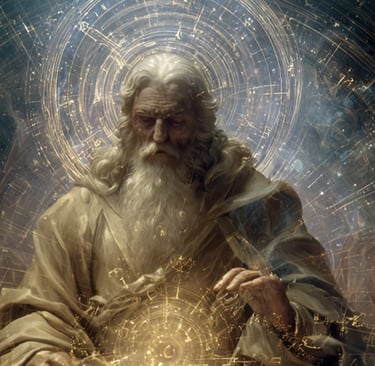

Understanding Gnosticism: An Ancient Path to Divine Knowledge
Introduction: What is Gnosticism?
Gnosticism (from the Greek gnosis, meaning "knowledge") represents not a single unified religion but a diverse collection of ancient spiritual movements that flourished alongside early Christianity and Judaism during the first through third centuries CE. These traditions share a revolutionary cosmological vision that challenges conventional religious assumptions about God, creation, and salvation.
What distinguished Gnostics from their orthodox contemporaries was a radical restructuring of divine reality: they proposed that the material world was not created by the supreme God, but by a lesser, flawed deity, and that salvation comes not through faith or obedience, but through direct spiritual knowledge of one's true divine nature.
The Gnostic Cosmology: A Hierarchy of Divine Being
The Unknown God: The Transcendent Monad
At the apex of Gnostic theology stands the Unknown God, sometimes called the Monad (the One) or the Invisible Spirit. This ultimate divine reality possesses characteristics that set it apart from the creator god of orthodox Judaism and Christianity:
Utterly transcendent: Beyond all categories, names, and descriptions
Purely spiritual: Entirely removed from matter and physicality
Perfect and complete: Lacking nothing, desiring nothing, unchanged by creation
Unknowable by ordinary means: Accessible only through direct mystical experience
This God is so utterly "other" that it could not, and would not, create the flawed, suffering-filled material universe we inhabit.
The Pleroma: The Fullness of Divine Emanations
Between the transcendent Monad and the material cosmos exists the Pleroma (Greek for "fullness"), a realm of divine emanations called Aeons. These are not separate gods in the polytheistic sense, but rather individuated expressions or aspects of the divine nature that flow forth from the Unknown God in hierarchical pairs.
Different Gnostic schools enumerated different Aeons, but common figures include:
Barbelo: The first emanation, the "Mother-Father" of all
Christ (the Logos): The divine Word and revealer
Sophia (Wisdom): Whose fall often precipitates material creation
Autogenes (Self-Generated): The perfect human archetype
These Aeons represent what orthodox Christianity might call the Trinity, distinct divine persons sharing one substance, but expanded into a rich hierarchy of spiritual beings. They are "many individual gods" who are nevertheless "one in spiritual substance," all participating in the divine nature of the Monad.
The Demiurge: Creator and Cosmic Tyrant
The material universe, according to Gnostic teaching, was not created by the true God but by a lesser being called the Demiurge (Greek for "craftsman" or "artisan"). This figure, often identified with Yaldabaoth or Saklas in Gnostic texts, is typically portrayed as:
Ignorant: Unaware of the higher spiritual realms above him
Arrogant: Declaring "I am God, and there is no other God beside me" (echoing Isaiah 45:5)
Flawed or malicious: Creating an imperfect, suffering-filled world
Many Gnostic schools identified the Demiurge with the God of the Hebrew Bible, the deity who creates the material world, gives the Law, and demands exclusive worship. This identification allowed Gnostics to explain the perceived contradictions between the vengeful, jealous God of the Old Testament and the loving Father proclaimed by Jesus.
The Archons: Rulers of the Material Prison
Serving under the Demiurge are the Archons (Greek for "rulers"), cosmic powers who govern the material realm and keep human souls trapped in ignorance. These beings are often associated with:
The seven planetary spheres: Each ruled by an Archon who must be passed in the soul's ascent
Cosmic law and fate: The deterministic forces that bind humans to material existence
Spiritual blindness: Active prevention of gnosis and awakening
The Archons represent the hostile spiritual forces that oppose human enlightenment and liberation.
Biblical Reinterpretation: The Gnostic Reading of Scripture
The "Ruler of This World"
Gnostic interpreters found powerful support for their cosmology in Jesus' own words about the "ruler of this world" (archon tou kosmou):
John 12:31 - "Now is the judgment of this world; now the ruler of this world will be driven out."
John 14:30 - "I will not speak much more with you, for the ruler of the world is coming. He has no claim on me, but I do as the Father has commanded…"
John 16:11 - "...and about judgment, because the ruler of this world has been condemned."
For Gnostics, these passages were not references to Satan as a fallen angel, but to the Demiurge himself, the cosmic ruler who claims authority over the material world but has no legitimate claim on Christ, who comes from the higher, transcendent God. The "judgment" and "condemnation" of this ruler represents the ultimate triumph of gnosis over ignorance.
Additional Biblical Support
Gnostics reinterpreted numerous biblical passages through their dualistic lens:
2 Corinthians 4:4 - "The god of this world has blinded the minds of unbelievers" became a reference to the Demiurge's deceptive rule.
Galatians 4:3, 9 - Paul's references to being "enslaved to the elemental spirits (stoicheia) of the world" were read as descriptions of the Archons' cosmic tyranny.
Genesis 1:26 - "Let us make man in our image" suggested multiple creators (the Demiurge and Archons), not the Trinity.
Genesis 3 - The serpent becomes a positive figure, the bringer of knowledge who encourages humanity to eat from the Tree of Knowledge despite the Demiurge's prohibition.
1 Corinthians 2:6-8 - Paul's mention of "rulers of this age" who crucified the Lord of glory was interpreted as the Archons, not human authorities.
This hermeneutical strategy allowed Gnostics to claim continuity with Christian scripture while completely inverting its traditional meanings.
The Nature of Gnosis: Salvific Knowledge
What is Gnosis?
Gnosis is not intellectual knowledge about doctrines or historical facts. Rather, it is:
Experiential and mystical: A direct encounter with divine reality
Self-knowledge as God-knowledge: Recognition of one's true spiritual nature
Revelatory: Usually transmitted through visions, mystical experiences, or initiation
Liberating: Knowledge that frees the soul from cosmic bondage
As the Gospel of Thomas states: "If you bring forth what is within you, what you have will save you. If you do not have that within you, what you do not have within you will kill you."
The Divine Spark Within
Central to Gnostic anthropology is the belief that within certain humans exists a pneuma (spirit) or "divine spark", a fragment of the transcendent God that has become trapped in matter. Salvation consists in:
Awakening to one's true spiritual identity
Remembering one's origin in the Pleroma
Acquiring knowledge of the Archons and their passwords
Ascending through the planetary spheres after death
Reuniting with the divine fullness
This is why one Gnostic text declares: "Know yourself, and you will know the Father."
The Redeemer Figure
In Christian Gnostic systems, Christ functions not as a sacrifice for sin but as a revealer and messenger who descends from the Pleroma to deliver saving knowledge. His role includes:
Awakening souls to their true spiritual identity
Teaching the secrets necessary to escape the Archons' realm
Modeling the path of return to the divine fullness
Empowering individuals to discover the gnosis within themselves
The Gnostic Christ often appears as a pure spirit who only seemed to have a physical body (a doctrine called Docetism), since true divinity could not be contaminated by matter.
The Major Gnostic Schools
Sethian Gnosticism
The Sethian tradition, reflected in texts like the Apocryphon of John and Gospel of the Egyptians, centered on Seth, the third son of Adam and Eve, as the ancestor of the true spiritual race. Key features include:
Highly philosophical cosmology with complex emanations
Reverence for the serpent in Eden as a liberator
Heavy influence from Jewish wisdom literature and Platonism
Ritualistic baptism for spiritual rebirth
Valentinian Gnosticism
Founded by Valentinus (c. 100-160 CE), this became the most widespread and sophisticated Gnostic school. Distinctive elements include:
30 Aeons arranged in male-female pairs within the Pleroma
Three classes of humanity: Pneumatics (spiritual, destined for salvation), Psychics (soul-based, potentially salvageable), and Hylics (material, bound to destruction)
Myth of Sophia: Her desire to know the Father causes her fall and the creation of the material world
Valentinian sacraments: Adapted Christian rituals with Gnostic interpretations
Marcionism
Marcion of Sinope (c. 85-160 CE) taught a radical dualism that, while debated by scholars, shares Gnostic features:
Two Gods: The just but harsh God of the Old Testament versus the loving, merciful God revealed by Jesus
Rejection of the Old Testament: Complete dismissal of Hebrew scriptures
Canonical revision: Accepted only edited versions of Luke and Paul's letters
Docetic Christology: Christ only appeared to have a physical body
Though Marcion emphasized Christology over cosmology, his dualistic framework parallels Gnostic thought.
Mandaeanism
The Mandaeans are the only Gnostic group to survive continuously from antiquity to today (primarily in Iraq and Iran). Their tradition includes:
John the Baptist (not Jesus) as a central prophet
Rejection of Jesus and Old Testament prophets
Elaborate ritual baptisms in flowing water
Complex cosmology with ascending worlds of light
Strict ethical codes and ascetic practices
A Modern Reinterpretation: Gnosticism for the 21st Century
While historical Gnosticism emphasized escape from the material world, a contemporary reinterpretation might offer a more integrated vision:
The Material World as Sacred Crucible
Rather than viewing matter as purely evil or a mistake, we might understand it as a necessary environment for spiritual growth. The challenges, suffering, and limitations of physical existence become opportunities for the soul to develop, mature, and achieve consciousness. This transforms cosmic pessimism into a more balanced perspective where incarnation serves a purpose.
The Demiurge as Unconscious Creator
If the material world serves a spiritual function, the Demiurge shifts from villain to unwitting facilitator, perhaps even an immature aspect of the divine itself. This figure establishes natural laws, cause and effect, and the structure within which souls can learn and evolve. The Demiurge's ignorance becomes not malice but limitation.
Gnosis as Wholeness and Integration
Salvific knowledge might be reframed not as escape from the body but as integration of spirit and matter. The goal becomes recognizing that the divine Monad is both transcendent (beyond the world) and immanent (within all creation, including matter itself). This leads to an ethic of engagement: sanctifying the world, working for justice, and treating physical reality with reverence as part of the total divine expression.
This synthesis honors Gnosticism's core insight, that conventional religion often mistakes a limited view of God for ultimate reality, while avoiding world-denying pessimism.
Why Gnosticism Resonates Today
Modern seekers often find Gnostic themes compelling because they address contemporary spiritual concerns:
Critique of institutional religion: Gnosticism's anti-authoritarian emphasis on direct experience appeals to those alienated by hierarchical churches
The problem of evil: Gnostic dualism offers an explanation for suffering that doesn't blame humanity or make God responsible
Individual spiritual authority: The emphasis on personal gnosis empowers individual religious experience
Esoteric knowledge: The appeal of hidden wisdom and secret teachings
Psychological depth: Gnostic myths map onto modern depth psychology's exploration of consciousness
Conclusion
Gnosticism represents one of history's most radical religious visions, a complete inversion of conventional theology that places spiritual liberation above institutional authority, direct experience above received doctrine, and the quest for self-knowledge at the center of religious life. Whether embraced as a living spiritual path or studied as a fascinating historical phenomenon, Gnostic thought continues to challenge comfortable assumptions about God, creation, and the nature of salvation.
For those drawn to its vision, Gnosticism offers not just an alternative cosmology, but an invitation to awaken to one's true nature and to see the world, and oneself, with radically new eyes.
info@churchofwambo.org
© SDBEST LLC, 2025. All rights reserved.
